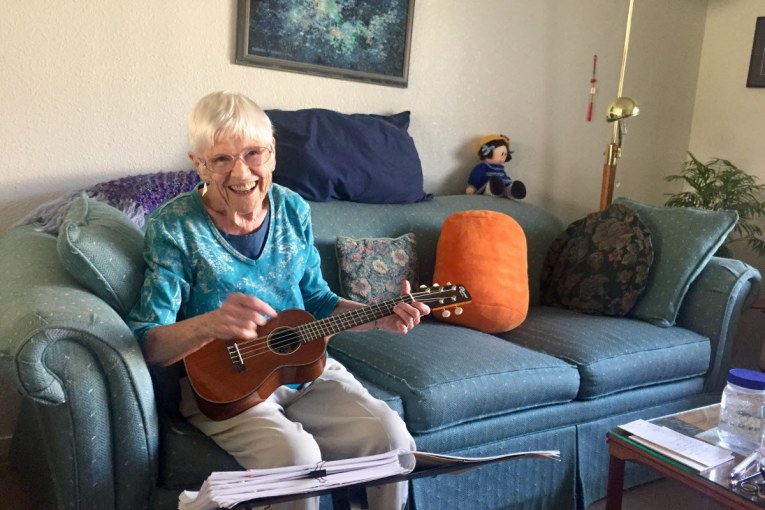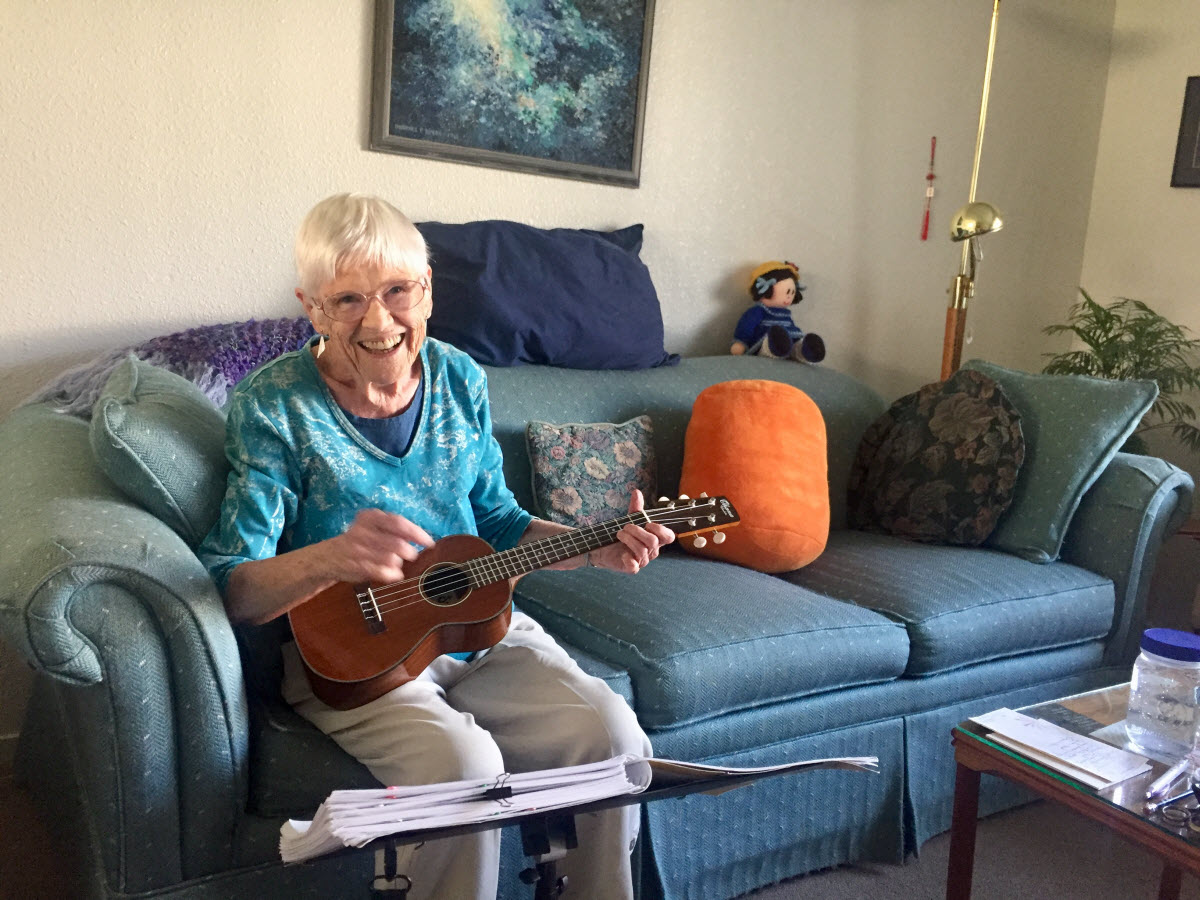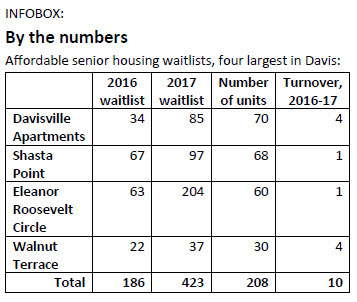

More than 400 on lists for a place to live in Davis
(Sponsored article – paid for by West Davis Active Adult Community) – The average wait for affordable senior housing in Davis is three to five years.
That’s a lot for Audrey Lippman, 94. She’s been on the list for Eleanor Roosevelt Circle since January. “Nobody has died,” she joked. “They told me, ‘Don’t even think about it for about a year.’ I, personally, am not holding my breath.”
Lippman is one of more than 423 on waiting lists for the four main affordable senior housing projects in Davis. They are Davisville Apartments, 1121 Kennedy Place, which has 70 units; Shasta Point at University Retirement Community, 1515 Shasta Drive, 68 units; Eleanor Roosevelt Circle, 675 Cantrill Drive; 60 units; and Walnut Terrace Apartments, 3101 Fifth St., 30 units.
Applicants must meet criteria of 25 percent, 50 percent or 60 percent of medium income in Yolo County. Each project is financed by different sources, and the financing determines the proportion of units serving what percent of the population. Government funding establishes the rent for each unit, and how much of that is subsidized, experts say.
For eligibility under 2017 state guidelines, a single senior must make no more than $32,300 annually, which is 60 percent of the median income for Yolo County ($41,950). A couple is eligible if earnings are $36,900 or less. Funding is often restricted further, to those considered 50 percent ($20,975) or 25 percent of the median area income.
less. Funding is often restricted further, to those considered 50 percent ($20,975) or 25 percent of the median area income.
Asked if she was on a fixed income, Lippman replied: “Oh, am I ever. I’m on Social Security, and grateful for it. I feel well cared for.”
She qualifies for Section 8 housing, which pays a substantial portion of her rent at Twin Pines Mutual Housing Community, an affordable housing complex on F Street, on the north edge of Davis. She and her husband, who died 10 years ago, were one of Twin Pines’ original occupants 20 years ago. Her one-bedroom ground-floor apartment is a little over 600 square feet.
Although seniors are eligible to apply for any low-income housing (like Twin Pines), Lippman says she’s ready to be closer to town, with more transportation options, surrounded by other active adults. “Here, it’s more people who are working and going to school.”
She’s enjoyed the mix of ages at Twin Pines but looks forward to more interaction and activity. “I’ve learned to be my own best friend. While I have my health, I’ve learned to be by myself, read and play ukulele. I invite people over.”
If she doesn’t get off the waiting list, she’s still grateful they moved to Davis from Santa Clara 20 years ago, to be near her daughter, former Davis Mayor Ann Evans. “If I were waiting to get
into Davis, I’d be tearing my hair out. I like living in a community. Davis is like a country town compared to Santa Clara.”
Bill Powell, president of Davis-based, Delta Senior Housing Communities, said, “Generally, people on the waiting list are related to somebody in Davis and have a pre-existing relationship to Davis.”
Delta Senior Housing, a nonprofit corporation serving low- to middle-income seniors, built Eleanor Roosevelt Circle. “Those places get taken pretty quickly,” Powell said.
“More and more people joining the ranks of being seniors,” Powell said. “Based on the numbers we see at Eleanor and other places around town, especially dealing with lower-income seniors, there’s a definite need. For some reason, we’re not seen as having a real need.”
Why are the waiting lists so long? Powell, who also serves on the Davis Senior Commission, attributes some to UC Davis students who come and stay, then attract their parents. “Davis continues to grow” but can’t keep  up with the demand.
up with the demand.
Davis’ four main apartment communities set aside for income-restricted seniors equate to 208 units. More than twice that many applicants are on the waiting lists. Just 10 apartments became available in the last year and a half, according to an informal survey conducted by the city of Davis in February 2016, and by the West Davis Active Adult Community in September and October 2017. The two largest and most popular communities – Eleanor Roosevelt Circle and Shasta Point – each had just one turnover in that time.
Lippman said more senior housing is needed. “I know someone who has a home and lives by himself, they don’t need all that space but where do they go? They can’t rent anything. There’s no place to go. They can’t handle that much space. We need new housing.”
But there’s not much on the horizon to ease the Davis housing crisis. Eleanor Roosevelt Circle, which opened in 2007, was the last affordable senior complex approved in Davis. There’s one proposal in the pipeline that would include affordable options for seniors. West Davis Active Adult Community would add 150 units of income-restricted senior apartments, likely limited to households with at least one family member age 62 or older. If the project goes to voters and is approved, the first phase of 75 units would be available as early as 2022, with another 75 units five years later.
West Davis Active Adult Community is sponsoring this section on the Vanguard because we believe providing more information is better.
Previous articles:
- Active Adults Are Backbone of Local Nonprofits
- Active Adults Having Trouble Finding a Home In Davis
- Former UCDMC CEO Working to Make Senior Housing Project a Reality
- Meetings Continue for West Davis Active Adult Community
- Developer Explains Plan for Active Adult Community Development Project
- Housing Prices Have Ripple Effect on Schools

I saw the same article in another local publication but it was not labeled as an advertisement.
Yep, that’s why.
How many people are on waitlists for affordable housing in Davis without regard to age? Ms. Lippmann is one of the fortunate few who has a Section 8 voucher. The Section 8 voucher waitlist itself is huge and usually closed. We have an affordable housing shortage, not an affordable senior housing shortage. Age-restricted housing that discriminates against families with children, students, and other low income households is not the answer.
Eric, affordable housing lists are regional. The advertiser is promising we won’t end up with any undesirable outsiders. That point is very clear,no “stranger danger” here.
In my opinion the table provided in this article tells a very clear story. Specifically that there is more than enough demand for senior housing that the buildings should be multi-story (ideally at least 4 stories) served by senior accessible elevators, with individual one-story units (of various sizes without any stairs and with universal accessibility).
Such units would not burden their senior residents with yard maintenance, and because land costs would be spread over four stories of units, the affordability of each individual unit would be much less on a $ per square foot basis. Entitlement costs (including Measure J/R costs) would also be spread over four stories of units, making affordability even greater.
As I said in public comment at Tuesday’s Council meeting, the current WDAAC design is a throwback to the post-War developments 60 years ago in Levittown New York.
Not all ‘seniors’ need ADA accommodations… not all who need ADA accommodations are ‘seniors’…
Howard, I will take ownership of a failure in my use of semantics. What I was trying to advocate for is summarized in the following … residential units that incorporate Universal, Accessible, Usable Design.
I agree that UDP should be used as much as possible. For everyone’s sake… with the understanding of practicability, and cognizant of “costs” associated…
There may come a time when I pay more attention to the ‘stair lift’ ads on TV … but that day has not yet come… but I realize it may, for me and mine.
Yeah, think we are talking nuances, not main principles… thank you for the clarifications…